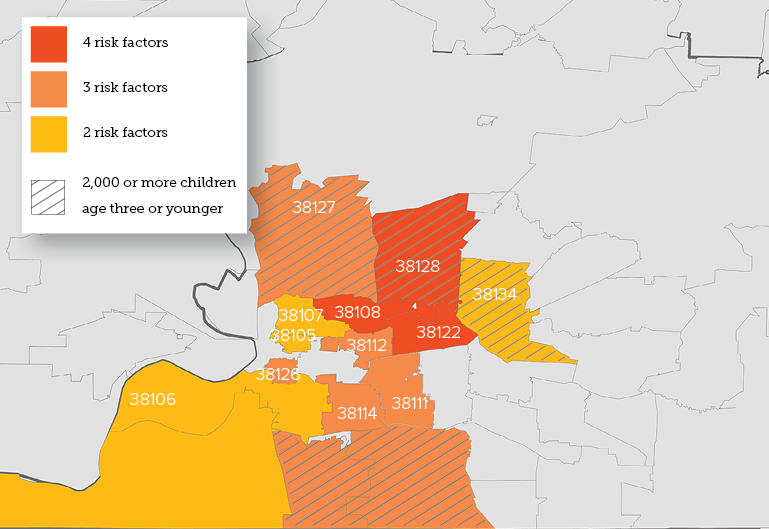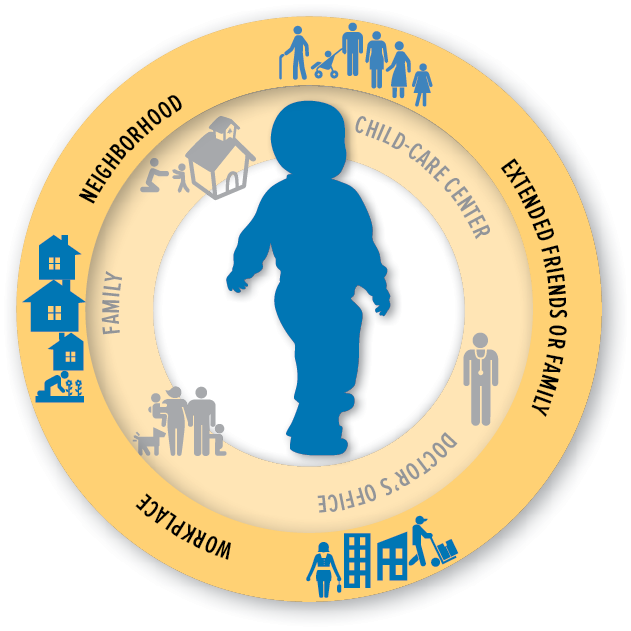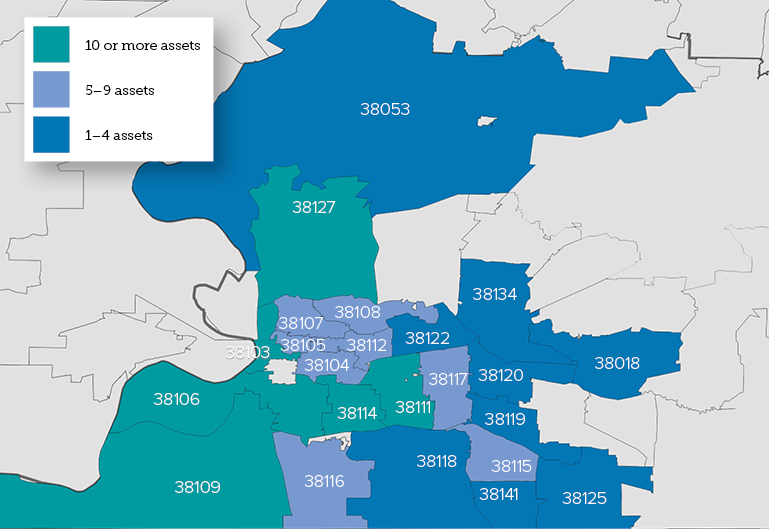How Can People in the Community Get Involved?
This book highlights factors known to affect children’s social and emotional development. While it does not cover all factors, mostly due to data gaps, it was designed to provide information on key factors that may be addressed or strengthened within the Shelby County community. These include factors in the home and child-care environment.
It is the hope of The Urban Child Institute that every reader of this book will identify some way in which he or she can support the social and emotional development of children in Shelby County. Some may be compelled by a topic, such as high rates of parental stress (particularly among younger, single mothers), while others may be more driven to make a difference in a specific community. Regardless, each effort, no matter how small or large, can positively affect the children of our community.
Where can individuals and organizations focus their efforts?
For the past ten years, community service providers in Shelby County have been proactive in educating themselves on the science of early childhood brain development and taking action to improve the state of young children in our county. This book has drawn attention to several efforts in Shelby County that are ongoing (a more complete list of organizations working in this area can be found in Appendix B). While investments have certainly grown, they remain limited overall, and there are many opportunities to get involved.
While virtually every neighborhood within Shelby County would benefit from additional focus on the social and emotional development of its youngest citizens, there are several areas that are at higher risk for poor child outcomes. By examining communities where children face multiple risks to their social and emotional development, decisions about resource allocation and investments in the community can become data-driven, resulting in better outcomes and a higher return on investment.
The map above (Figure 5.1) provides information on the geographic regions at higher risk for poorer social and emotional outcomes among young children. It maps an index that includes several factors discussed earlier in the book:
- High proportion of zip code living in poverty (40 percent or more living below the FPL)
- Low maternal education (20 percent or more of mothers who did not graduate from high school)
- High proportion of single parents (40 percent or more of children who live with their single mother or single father)
- Lower-quality child care (fewer than 80 percent of child-care slots have a three-star rating)
The map also highlights those areas with a high concentration of young children (2,000 or more children ages three or younger). These areas may be worth particular attention.
As shown on the map, zip codes 38108, 38111, 38112, 38114, 38116, 38118, 38122, 38126, 38127, and 38128 have three or four risk factors. Of these, 38116, 38118, 38127, and 38128 also have the highest number of children, suggesting that these areas may be ripe for interventions or support and that such activities would reach a large number of young children with high need. It is important to note that the data presented in this map are illustrative. Other risk factors could be considered or the thresholds for “high risk” changed. As such, these data should not preclude investments in other zip codes or regions within Shelby County. The fact that a region is not highlighted on the map does not mean it wouldn’t also benefit from investments. These data are intended to support and inform, not override, local knowledge and decision-making about resource allocation.
How can we leverage community assets?
As shown in the model of development that we have used throughout this book (Figure 5.2), child development does not exist in a vacuum. This book explored the home and child-care settings more specifically, but even these settings exist within a larger community structure.
For example, parents may be able to build social and emotional competencies of their children by taking them to programs and experiences within the community, such as story hour at the local library, or a nature walk at a local park, where children learn to interact with other children and adults in various settings. Child-care providers may take field trips to the community garden or to the local fire station, again providing varied experiences for children and an opportunity to learn critical skills for how to interact in groups and behave in new settings. Such experiences do not have to be expensive; many are offered at no or low cost to the community. Figure 5.3 maps out the location of several of these community assets: libraries, zoos, museums, parks, playgrounds, and community gardens. While there are likely other community assets not mapped, this is intended to provide a high-level snapshot of these assets and their relative location compared to the neighborhoods of opportunity noted above.
If you compare this map (Figure 5.3) to the map of risk factors in home and child-care settings (Figure 5.1) you may notice something surprising. Areas with the most high-risk children, in some instances, have many assets. Zip code 38127, for example, has 11 assets, while zip codes 38111 and 38114 each have ten. This is important to note, because communities may have important resources from which to build upon and there may be a community infrastructure that could be leveraged to support the social and emotional development of young children. Work may need to be done or investments made to improve the safety, quality, or quantity of offerings to young families (e.g., play groups at the park). It may also be that more efforts need to be made in connecting families to these community assets and resources, so they are aware of what is available.
Where is more information needed?
This book is just a start to summarize what we know about social and emotional well-being for children in Shelby County. While Appendix A provides a list of data sources that can provide additional information on social and emotional development, with the exception of the CANDLE data, little information is available at a local level to inform decision making. We require more information to help us target resources and better meet the needs of young families. Here are some examples:
About the child:
- Are there ways to track social and emotional development in children from birth to age five in Shelby County?
- How does social and emotional development affect school readiness for children in Shelby County?
In the home:
- What activities are parents and other caregivers doing to nurture child social and emotional development? How are fathers engaged?
- What programs are best for Shelby County families to support the emotional readiness of children, and how might that differ by neighborhood or family background?
In the child-care setting:
- How are children in kinship care (care of children by relatives) faring, and what supports are available to nurture social and emotional development?
- What are child-care providers doing systematically to nurture social and emotional development? And what activities are best?
- We need to better understand more about investments in supporting social and emotional development early in childhood that will have positive outcomes and cost savings down the road.
How to help
As noted throughout this book, there are numerous ways to help support the social and emotional development of young children in Shelby County. It is important to keep in mind that there is no “right way” to help; everyone in the community has different skills, resources, and time available. Providing an hour of child care for a mother who is highly stressed is just as important as expanding an evidence-based parent program into a new neighborhood. In this book, we focused on the home and child-care settings. Here are some ideas for each:
In the home or surrounding community:
- Child-care providers can work with families to provide support and strengthen home-based strategies to cultivate child social and emotional skills.
- Parents, other caregivers, and their supporters can advocate better programs that support social and emotional development. Determine what the needs are in the community, as well as what is working— and what is not.
- Care for children. Provide a warm, nurturing environment and opportunities for them to explore, learn, and grow.
In the child-care setting:
- Expand evidence-based practices that have demonstrated impact in supporting the social and emotional development of children.
- Create new partnerships in the community. Are there organizations with whom you could partner that could support the development of social and emotional competencies of young children in your child care facility?
- Train child-care providers, parents, and other adults responsible for the well-being of children. Given the importance of parent-child interactions and provider-child interactions for the development of social and emotional competencies, training and professional development opportunities should be made available that focus on these issues specifically.
Conclusion
Many children in Shelby County are at risk of not developing to their full potential. Many face multiple risks, including growing up in poverty and having younger mothers with less life experience and education. Raising a child in such an environment is exceedingly difficult for a parent and can result in higher stress, which in turn can affect the warmth and responsiveness of the parent toward the child. In addition, many children spend a significant amount of time in a child-care setting. Though many programs offer high-quality care, there are children spending time in programs that could be doing more to support their social and emotional development. As a community, we have a unique opportunity to consider these risks and the implications that they have for the children of Shelby County. Working together, we can help to strengthen these skills within our youngest children and set them up for lifelong success.


